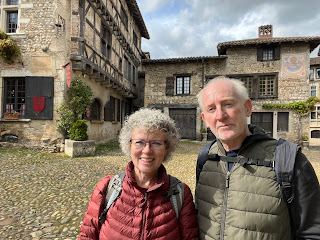 |
| Pèrouges |
Pérouges
Once upon a time long, long ago, there was a town built of wood and stone atop a hill overlooking the plain of the river Ain. The medieval town of Pèrouges is so well-preserved that visiting felt like stepping back in time and into a fairy tale.
Click for our photo album here.
Our tourist map described some of the buildings’ past and/or current usages painting the picture of a once prominent fortified town ringed by ramparts that saw some action before fading when the trade route shifted. Humans have been here since the Chalcolithic period. Legend has it that the town was founded by a Gallic colony returning from Perugia, Italy long ago. The fortress was built in the 12th century. The town prospered until the 19th century. In the beginning of the 20th century it was partially abandoned and threatened with demolition. It’s since been revived and is wonderful to visit (despite the cold wind) as the pictures will attempt to capture. We soaked in the medieval ambiance which is only occasionally interrupted by modern conveniences such as cars and plumbing.
As you might imagine, this town has been the setting of several movies. We roamed, consulted our guide, peering into windows and poked about in shops. There were quite a few art shops for such a small place but it seems fitting that artists would be drawn here. Needing a snack, we knocked on a window and bought galettes de Pèrouges which is a round flat pastry similar to shortbread covered in butter and sugar then baked to crunchy perfection.
Friends in La Bégude-de-Mazenc
Laure Wolville was an exchange student who lived with my family when we were both in high school. Laure and I enjoyed catching up and she and her husband Stephane made us feel welcome in their beautiful home. Having had few opportunities to see the inside of old homes, we were impressed with the 17th century construction of the farm house and barn which had been converted to a bed and breakfast with a pool.
Stephane explained that they were the fourth owners of the house and the owners previous to them had carried out the conversion. We chatted in their cozy living room with a fireplace which had once been the barn. The bathroom in the room we were staying in had massive overhead support beams and a slightly curved roof with exposed brick overhead. Our time together was brief as they were going on vacation but they generously invited us to stay and we enjoyed several nights here. We relaxed, caught up on chores, wrote, took long walks down country roads and visited some small historic towns and sites they suggested.
Le Poët-Laval
Church of Saint-Pierre-et-Saint-Paul de Comps
A long drive through hairpin curves brought us up to this remote Romanesque church that was a Benedictine Priory. We had to settle for the imposing exterior views as it was also closed.
Saou
This is a city with a great blend of old and new. By the time we got here it was late afternoon and the TI was closed. We followed the markers and signs pointing us up, up, up to the tower.
I had assumed it was a fortified castle but it was actually a prison. In for a penny, we got our audio guide headgear which started on its own as we entered each room. The mannequins were pretty sad looking but the audioguide described the very harsh treatment of Protestants and protesters well. The views out over the tiled roofs of the old town were amazing from every level. My phone tells me we climbed 29 floors that day. Probably more than I climb in a month in Florida.
Montélimar
As the largest nearby city, we didn’t spend long here but it was good for shopping and we found the site of the ancient marketplace (now small square) and a leafy park with sheep, goats and chickens.
Dieulefit
This town still has buildings that were constructed in the 12th century and small twisting streets and alleys - all with stories to tell. Its yet another place where religious wars caused irreparable harm. Today it’s picturesque and known for ceramics. We visited on May 1 which is France’s Labor Day and we found most places closed - yes that seems to be a theme.
Doors and Door Nails - dead and otherwise
I love old doors and have wondered why they’re often full of studs or nails that serve no structural purpose. According to more than one source they protected external doors from the swords and axes during enemy attack.
That explains some doors but doesn’t really explain their on-going use on doors that are unlikely to be hacked by invaders. And what about the idiom “Dead as a door nail?” Turns out that’s because the nail would be driven in from the front and clinched (bend) on the back so it couldn’t be used again and therefore “dead.”
And since we’re in France, why are there French Doors? The French designed a window-like-door between the 16th and 17th century with glass panes that extended from top to bottom to provide more light.
Next stop: Marseilles











hey Dermot and Dee, it is good to see you again. so busy that i hardly get a chance to read/view your travels. just having some work done on the house today. i did not realize how many places you have been to. sheesh, it looks like fun. i hope the van is no problems and your health is good. thanks for sharing your thoughts and pictures. be safe out there! and see you when you get back. peace. out.
ReplyDeleteHi Mike. We're doing great, thanks. Hope you're doing well. We're back now and need to get together!
ReplyDelete